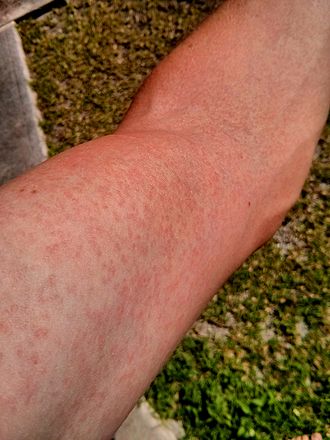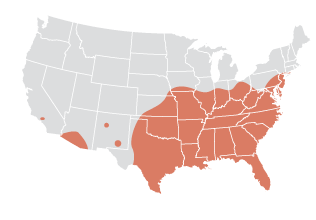Zika virus
| https://https://www.youtube.com/watch?v=oGNxGlltnOs%7C350}} |
|
Zika virus infection Microchapters |
|
Diagnosis |
|
Treatment |
|
Case Studies |
|
Zika virus On the Web |
|
American Roentgen Ray Society Images of Zika virus |
| Zika virus | ||||||||
|---|---|---|---|---|---|---|---|---|
 rash on arm due to Zika virus - By FRED - Own work, CC BY-SA 3.0, https://commons.wikimedia.org/w/index.php?curid=30734915
| ||||||||
| Virus classification | ||||||||
|
Editor-In-Chief: C. Michael Gibson, M.S., M.D. [1]; Associate Editor(s)-in-Chief: Yazan Daaboul, M.D., Nate Michalak, B.A., Serge Korjian M.D., Yamuna Kondapally, M.B.B.S[2]
Overview
Zika virus infection is caused by Zika virus, an enveloped, single stranded positive sense RNA virus. Zika virus is a type of flavivirus. Mosquitoes are the primary disease vector of Zika virus.
Microbiological Characteristics
- Zika virus, also known as ZIKV is an enveloped, icosahedral virus with a single-stranded, positive sense RNA genome. The most closely related virus is the Spondweni virus and is one of the two viruses in the Spondweni virus clade.[1]
- The Zika virus genome consists of 10,794 nucleotides that encode 3,419 amino acids.[2]
- Zika virus is a member of the Flaviviridae family and of the flavivirus genus.
- There are two lineages for Zika virus: African and Asian.[2]
Transmission
Mosquito Vector Transmission
Transmission of Zika virus to humans is thought to occur mainly through infected mosquitoes.
- The following species have been identified as vectors for Zika virus:[3]
|
|
The table below compares the characteristics of 2 common Aedes species: Ae. aegypti and Ae. albopictus
| Aedes aegypti | Aedes albopictus |
| Bright, silvery, lyre-shaped dorsal pattern and white banded legs | Single longitudinal silvery dorsal stripe and white banded legs |
| Urban areas with or without vegetation | Associated with thickets and arboreal vegetation |
| Bites, rests, and lays eggs both indoors and outdoors | Mostly an outdoor (garden) mosquito |
| Sneaky biter | Aggressive biter |
| Blood from humans mainly, and domestic mammals to a lesser extent | Humans and domestic and wild vertebrates |
| Major production places are human-made containers, treeholes, and bamboo internodes holding water | Preference to treeholes and bamboo internodes with water, can also utilize human-made containers for its immature development |
| Most containers with water used for immature development are within or in close proximity to households | Utilizes water-filled containers around or further away from households |
  |
 
|
Table adapted from the Centers for Disease Control and Prevention (CDC)[3]
Read the CDC infographic on life cycle of Aedes aegypti mosquito here
Human-to-Human Transmission
Zika virus can be trasmitted via mother to child and sexual trasmission.
Mother to child
- A pregnant woman who is already infected with Zika virus can pass the virus to her fetus during the pregnancy or around the time of birth.
- Zika virus has been detected in amniotic fluid, which suggests that Zika virus may cross the placental barrier and vertical transmission is possible.[4] Mosquito-borne ZIKV is thought to initially replicate in dendritic cells near the site of inoculation before spreading to lymph nodes and then the bloodstream. ZIKV can be killed by potassium permanganate, ether, temperatures >60°C, but is not effectively neutralized by 10% ethanol.[2]
- There are no reported cases of Zika virus spread through breastfeeding. Due to the nutritional benefits of breastmilk, mothers are encouraged to breastfeed their infants even in areas where Zika virus is endemic.
Sexual transmission
- Zika virus can be sexually transmitted between humans.[5][6]
- It can be transmitted even if the infected person does not have symptoms.
- Zika virus remains in semen longer than in other body fluids (vaginal fluids, urine, and blood).[7]
Blood transfusion
- Zika virus can be transmitted via blood transfusion but there are no cases reported in United States.
- The transmission of virus through blood transfusion has been reported in Brazil. These cases are under investigation.
- On August 26, 2016, the US Food and Drug Administration (FDA) issued revised guidelines recommending universal testing of donated whole blood and blood components for Zika virus in the United States and its territories.
Laboratory exposure
- There has been one reported laboratory-acquired Zika virus disease in United States.[8]
Virology
- Following a mosquito bite, the incubation period for Zika virus in humans is approximately 3 to 12 days.
- Detection of Zika virus is primarily based on the isolation of RNA from blood serum through PCR in acutely ill patients.[9]
- An ELISA has also been developed by the Centers for Disease Control and Prevention to detect IgM against ZIKV.[2]
- Zika virus has a short viremic period, such that the virus may be detected in serum 3-5 days following the onset of symptoms. Zika virus can be detected in urine up to 10 days following the onset of symptoms.[9]
Refererences
- ↑ FIELDS, B. N., KNIPE, D. M., & HOWLEY, P. M. (2007). Fields virology. Philadelphia, Wolters Kluwer Health/Lippincott Williams & Wilkins.
- ↑ 2.0 2.1 2.2 2.3 Hayes EB (2009). "Zika virus outside Africa". Emerg Infect Dis. 15 (9): 1347–50. doi:10.3201/eid1509.090442. PMC 2819875. PMID 19788800.
- ↑ Duffy, Mark R.; Chen, Tai-Ho; Hancock, W. Thane; Powers, Ann M.; Kool, Jacob L.; Lanciotti, Robert S.; Pretrick, Moses; Marfel, Maria; Holzbauer, Stacey; Dubray, Christine; Guillaumot, Laurent; Griggs, Anne; Bel, Martin; Lambert, Amy J.; Laven, Janeen; Kosoy, Olga; Panella, Amanda; Biggerstaff, Brad J.; Fischer, Marc; Hayes, Edward B. (2009). "Zika Virus Outbreak on Yap Island, Federated States of Micronesia". New England Journal of Medicine. 360 (24): 2536–2543. doi:10.1056/NEJMoa0805715. ISSN 0028-4793.
- ↑ http://www.cdc.gov/zika/transmission/index.html CDC Transmission
- ↑ Musso D, Roche C, Robin E, Nhan T, Teissier A, Cao-Lormeau VM (2015). "Potential sexual transmission of Zika virus". Emerg Infect Dis. 21 (2): 359–61. doi:10.3201/eid2102.141363. PMC 4313657. PMID 25625872.
- ↑ Foy, B. D.; Kobylinski, K. C.; Foy, J. L. C.; Blitvich, B. J.; Travassos Da Rosa, A.; Haddow, A. D.; Lanciotti, R. S.; Tesh, R. B. (2011). "Probable Non–Vector-borne Transmission of Zika Virus, Colorado, USA". Emerging Infectious Diseases. 17 (5): 880–882. doi:10.3201/eid1705.101939. PMC 3321795. PMID 21529401.
- ↑ Zika virus transmission https://www.cdc.gov/zika/transmission/index.html (August 27, 2016) Accessed on September 15, 2016
- ↑ Zika Virus Transmission. Centers for Disease Control and Prevention (August 27, 2016). http://www.cdc.gov/zika/transmission/index.html Accessed on September 14, 2016
- ↑ 9.0 9.1 http://ecdc.europa.eu/en/healthtopics/zika_virus_infection/factsheet-health-professionals/Pages/factsheet_health_professionals.aspx ECDC Zika virus infection factsheet